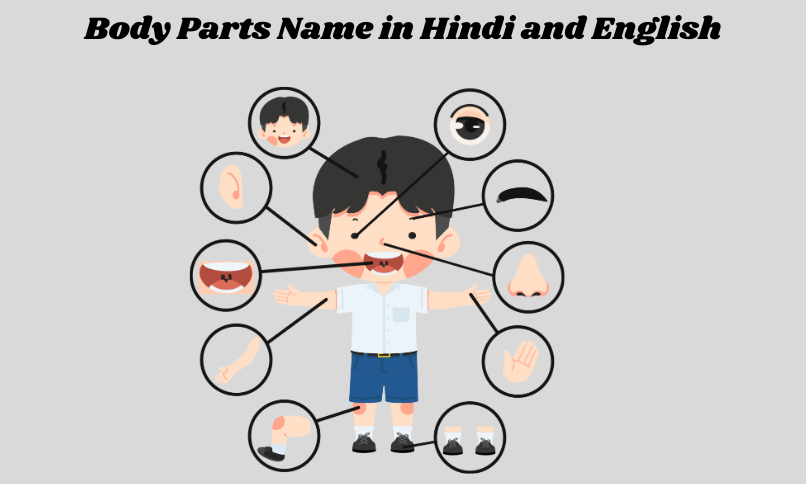Body Parts Name in Hindi and English
| English Name | Hindi Name | Definition/Explanation | Example Sentence (Hindi → English) |
|---|---|---|---|
| Head | सिर | The upper part of the body that houses the brain, eyes, ears, nose, and mouth. | “उसका सिर तेज़ दर्द से परेशान है.” → “His head is troubled by severe pain.” |
| Face | चेहरा | The front part of the head, which includes the eyes, nose, and mouth, often used to express emotions. | “उसका चेहरा बहुत आकर्षक है.” → “Her face is very attractive.” |
| Hair | बाल | The strands that grow from the scalp, serving both protective and aesthetic purposes. | “उसके बाल लंबे और घने हैं.” → “Her hair is long and thick.” |
| Eye | आँख | The organ of vision that allows us to see and interpret our surroundings. | “मेरी आँखें नीली हैं.” → “My eyes are blue.” |
| Ear | कान | The organ responsible for hearing and maintaining balance. | “उसके कान में सुंदर ईयररिंग्स हैं.” → “She has beautiful earrings in her ears.” |
| Nose | नाक | The facial organ used for smelling and breathing. | “उसकी नाक छोटी और सुंदर है.” → “Her nose is small and pretty.” |
| Mouth | मुँह | The opening on the face used for eating, speaking, and breathing. | “उसका मुँह हँसी से खुल गया.” → “His mouth opened in a smile.” |
| Neck | गर्दन | The part of the body that connects the head to the torso, allowing movement and support. | “उसकी गर्दन में चोट लग गई है.” → “She has injured her neck.” |
| Shoulder | कंधा | The joint connecting the arm to the body, which supports and allows a wide range of arm movements. | “उसके कंधे पर भारी बोझ था.” → “He carried a heavy burden on his shoulder.” |
| Arm | बाँह | The limb extending from the shoulder to the hand, used for various tasks like lifting and holding. | “उसने अपनी बाँह फैलाकर स्वागत किया.” → “She welcomed him with open arms.” |
| Hand | हाथ | The end part of the arm equipped with fingers, used for grasping and manipulating objects. | “उसने अपने हाथ से पुस्तक पकड़ी.” → “He held the book in his hand.” |
| Chest | छाती | The front part of the torso between the neck and the abdomen that houses vital organs like the heart and lungs. | “उसकी छाती में दर्द हो रहा है.” → “His chest is hurting.” |
| Stomach | पेट | The organ responsible for digestion, located between the chest and the abdomen. | “मेरा पेट भूख से कराह रहा है.” → “My stomach is growling with hunger.” |
| Leg | टांग | The lower limb used for standing, walking, and running; it supports the body’s weight. | “उसकी टांग में चोट लगी है.” → “He has injured his leg.” |
| Foot | पैर | The terminal part of the leg that makes contact with the ground during standing and walking. | “उसका पैर दर्द कर रहा है.” → “His foot is hurting.” |
| Back | पीठ | The rear part of the body, extending from the neck to the lower back, responsible for supporting posture. | “मेरी पीठ में दर्द है.” → “I have pain in my back.” |
| Heart | दिल | The vital muscular organ that pumps blood throughout the body via the circulatory system. | “उसके दिल की धड़कन तेज है.” → “His heart is beating fast.” |
| Liver | यकृत | A large, essential organ involved in detoxification, metabolism, and other biochemical functions. | “यकृत शरीर के लिए बहुत महत्वपूर्ण है.” → “The liver is very important for the body.” |
| Kidney | गुर्दा | One of the paired organs that filter waste products from the blood and produce urine. | “गुर्दे शरीर से अपशिष्ट निकालते हैं.” → “The kidneys filter waste from the body.” Contents Body Parts Name in Hindi and English Additional ExplanationHead (सिर)Face (चेहरा)Eye (आँख)Hair (बाल)Ear (कान)Nose (नाक)Neck (गर्दन)Mouth (मुँह)Arm (बाँह)Shoulder (कंधा)Chest (छाती)Hand (हाथ)Leg (टांग)Stomach (पेट)Foot (पैर)Back (पीठ)Heart (दिल)Liver (यकृत)Kidney (गुर्दा)Lungs (फेफड़े)Finger (उंगली)Spine (रीढ़ की हड्डी)
|
Additional Explanation
Learning Tip:
Studying body parts with their definitions and using example sentences can help you remember both the vocabulary and the context in which they are used. For example, knowing that “गर्दन” means “neck” and is the part that connects the head to the torso will make it easier to recall its function and practice sentences like “उसकी गर्दन में दर्द लग रहा है” (“She is experiencing neck pain”).Usage in Daily Conversation:
These terms are commonly used in everyday conversation, health discussions, and even in literature. Familiarity with both the English and Hindi terms enhances bilingual communication and understanding.
